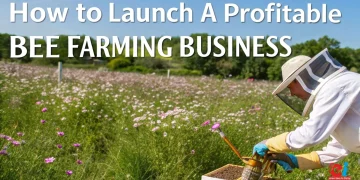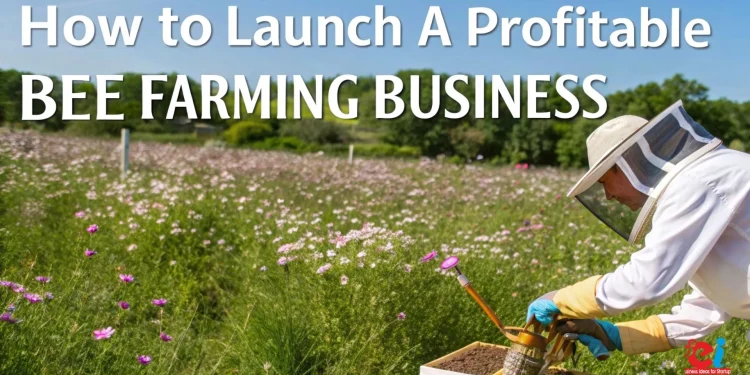In India, the Bee Farming Business and honey business has gained momentum as one of the highly potential and eco-friendly agri-based entrepreneurial undertakings in the country. The increasing awareness regarding health and wellness has accelerated the demand for honey to unprecedented levels in both national and international markets. Honey is no longer simply a natural sweetener—it’s a health product, an immunity enhancer, and a key ingredient in pharmaceuticals, Ayurvedic medicinal products, cosmetics, and processed foods. At the epicenter of this expanding ecosystem is bee farming—an economically accessible venture that requires minimal land and offers high financial returns.
Why 50 Bee Colonies Make an Ideal Starting Point
From a financial perspective, starting a bee farming business with 50 bee colonies is easily achievable for rural entrepreneurs, farmers, and agristartups, while at the same time serving a greater ecological purpose. Bees are essential for cross-pollination, increasing crop output and fostering biodiversity. This opportunity is further enhanced with government provided support, training programs, and schemes initiated under the National Beekeeping and Honey Mission (NBHM) allowing first-time entrepreneurs to explore new horizons. This article outlines a bee farming business with 50 colonies, estimating setup costs, income, and profit margins.
Setting Up a Bee Farming Unit: Requirements and Process
Every bee farming buiness operation starts with thorough planning, training, and site selection. An appropriate site should be located away from heavy vehicle movement, industrial areas, and rest zone of pesticide applying farms. Most optimally, it should be adjacent to orchards, mustard farms, eucalyptus plantations, or wildflower regions which guarantee ample supply of nectar and pollen throughout the year. Clean water and partial shade are also required.
Before starting the farm, basic apiculture training should be taken from KVIC, State Horticulture Boards, or Agricultural universities. They offer instruction on hive management, pest mitigation, queen production, seasonal relocation, and honey harvesting. These skills are very important in managing the bees and ensuring that they are as productive as possible.
The principal constituents of a 50 colony unit includes beehives (which are usually Langstroth hives) and bee colonies (with sufficiently mated queenbees). A bee veil, smoker, hive tools, honey extractor, protective clothing, and other tools are also required. Additional infrastructure includes a small shed or storeroom for equipment, honey filtering and bottling area, and water arrangements.
Related: Why Initiating Honey Processing Business
Cost Breakdown for 50 Bee Colonies
The initial investment and operational costs for a bee keeping unit with 50 colonies is manageable and allows for expansion. This is the summarized expenditure for start-up businesses as of today:
- Beehives (Langstroth Type) with Stands: Each hive costs around ₹2,000–₹2,500. The entire investment for 50 hives would amount to ₹1,00,000–₹1,25,000.
- Bee Colonies with Queen Bees: Colonies cost between ₹1,200 to ₹1,500 each. Hence, the total cost for 50 units will range from ₹60,000–₹75,000.
- Honey Extractor (Manual or Electric): ₹15,000–₹25,000 depending on size and brand.
- Beekeeping Supplies: ₹10,000–₹15,000 for all essential gear which encompasses hive tools, smoker, bee veil, gloves, etc.
- Bottling Unit (Small Scale): ₹20,000–₹30,000 will be needed for jars, caps, and filters.
- Shed Construction or Rental (Optional): A basic 100–150 sq ft room should cost around ₹20,000–₹30,000.
- Miscellaneous Contingency Costs: Making prepared funds available supports the rest of the costs such as feeding, migration, and maintenance. A sum of ₹25,000 was set aside to cater for unmapped majority costs.
Total Estimated Investment: ₹2.5 to ₹3 lakhs depending on local prices and quality of materials.
Honey Yield, Income Potential, and Byproducts
Projections of income states that the main source will be sales of honey, return bee byproducts will include bees wax propolis and royal jelly. More advanced systems will also attach bee venom as a source of revenue.
Moving towards the cost, each colony yields on average of 8 to 10 kg of raw honey per season, of course under the good circumstances. A single colony has the potential to produce up to 20 kg per year. Given two harvesting seasons during spring and post-monsoon, this value can be achieved quite easily. For 50 colonies, annual honey yield can reach 750 to 1,000 kg.
Selling honey in bulk fetches a current market price of ₹150 to ₹180 per kg. In this case, you would yield an estimated profit of ₹1.1 lakh to ₹1.8 lakh per season and ₹2.2 to ₹3.6 lakh annually. However, those who bottle and retail the honey are able and willing to pay this same price at a wider range of ₹300 to ₹500 per kg. In this case, yearly income goes up from ₹3.75 lakh to over ₹5 lakhs.
Moreover, beeswax generated can be collected to Candles manufacturers, plant based creams and other beekeeping equipment companies. ₹20,000–₹25,000 can be made on this in turn bringing up grand total of ₹10,000–₹15,000.
Changing trends in ayurveda has enabled the development of wax candles, creams and lip balms further increasing the scope of profit. Making why goes a long way in terms of margin profit while aiding the health and beauty segment.
Related: Building a Profitable Medicated Honey Brand: Manufacturing, Positioning, and Market Entry Strategy
Government Schemes and Subsidies for Bee Keepers
The Indian government offers a subsidy of up to 40% on the purchase of beekeeping equipment, training, and setup costs for qualifying entrepreneurs under the National Beekeeping & Honey Mission (NBHM). Furthermore, The Khadi and Village Industries Commission (KVIC) and National Horticulture Board provide financial grants, supplementary aid, and access to low-interest loans for expanding the bee keeping and honey business.
For MSMEs, the Ministry aids with the development of honey processing and testing units. MSME entrepreneurs can register their ventures as micro-enterprises in order to receive working capital, credit guarantee schemes, and even export facilitation benefits through Udyam Registration.
Opportunity for Scaling and Market Positioning
Once your apiary is set up, you can increase the colonize number to 100 or even 200 through natural colony division alongside queen rearing. This decreases your per colony cost while significantly increasing your honey output.
By branding your honey under a distinct name while also aiding in eco-friendly packaging, you can achieve premium pricing when offering their products through organic stores, Amazon, and Flipkart. Partnerships with participating ayurvedic medicine brands, restaurants, or health food chains also offer prospective benefits.
In addition to expanding the base of your honey agricultural business to include herbal extracts, other agri-value chains like essential oils or even medicinal plants can help create more vertical integration.
Assistance Received from NIIR Project Consultancy Services (NPCS)
NIIR Project Consultancy Services (NPCS) will aid prospective entrepreneurs intending to start the beekeeping and honey business with NPCS step-by-step plans, which include detailed project reports (DPRs), loan applications, plant layout designs, marketing plans, machinery supplier lists, and cost estimations. NPCS has ensured that the business is adequately planned and ready for investment. Their consultancy covers all the technical and financial prospects of bee farming—ensuring maximum returns on investment.
NPCS also assists in making feasibility studies, identifying projects, and diversification of products into value-added ones—especially for those wishing to establish candle manufacturing units or Ayurvedic product lines alongside bee farming.
Summary: An Encouraging Development for Young Agro-Entrepreneurs
This business of bee farming and honey production in India offers great opportunities with low risks attached for rural farmers, women entrepreneurs, and MSMEs. With an investment of as low as ₹3 lakhs, and the right training, one can earn a decent income while aiding in enhancing agricultural biodiversity. Government support is active and strong, paired with new health-focused trends—making this a great window of opportunity to step into the market.
Be it a small niche or broader scope, bee farming guarantees steady income and long-term prospects for everyone. Consult with the NIIR Project Consultancy Services and let them assist you as you take your first steps into apiculture and agriculture ventures.


























